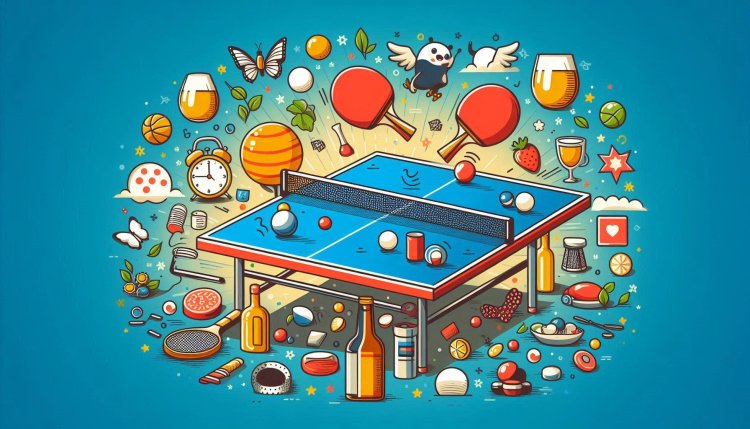Ping Pong vs Table Tennis: Understanding the Key Differences
Discover the differences between ping pong and table tennis, from historical origins to modern rules, equipment, and gameplay. Learn which term to use and why it matters.
The terms “ping pong” and “table tennis” are often used interchangeably, sparking curiosity about whether they refer to the same sport or distinct activities. While both involve paddles, a small ball, and a table divided by a net, subtle differences in terminology, rules, equipment, and context set them apart. This article explores the origins, regulations, and cultural nuances that differentiate ping pong from table tennis, helping enthusiasts and casual players understand these two sides of the same coin.
1. Historical Origins: How Ping Pong Evolved into Table Tennis
The roots of both games trace back to late 19th-century England, where lawn tennis enthusiasts adapted the sport for indoor play. The earliest version, known as “indoor tennis,” used makeshift equipment like books as nets and cigar box lids as paddles.
-
The Birth of “Ping Pong”
In 1901, the trademark “Ping Pong” was registered by English firm J. Jaques & Son Ltd., inspired by the distinctive sound of the ball hitting the paddle and table. The name became synonymous with the game, but its trademark status meant other manufacturers had to use “table tennis” to describe their products. -
Rise of Table Tennis as a Competitive Sport
By the 1920s, the game’s popularity surged globally, leading to the formation of the International Table Tennis Federation (ITTF) in 1926. To avoid legal issues with the “Ping Pong” trademark, the sport’s official name became “table tennis,” cementing its status as a competitive discipline. -

2. Terminology: Trademark vs. Official Sport
The primary distinction lies in terminology and branding:
-
Ping Pong: A trademarked name often associated with casual play or recreational equipment.
-
Table Tennis: The official name recognized by global sports organizations like the ITTF and the Olympics.
While “ping pong” remains a colloquial term, especially in the U.S., “table tennis” is used in formal, competitive contexts.
3. Equipment Differences: Paddles, Balls, and Tables
Though the basic tools are similar, subtle variations exist:
Paddles/Rackets
-
Table Tennis: Players use laminated wooden rackets covered with rubber sheets. ITTF regulations mandate one side be black and the other red, with strict rules on rubber thickness and surface texture.
-
Ping Pong: Paddles often have a sandpaper surface or basic rubber, prioritizing affordability over spin or speed. These are common in casual settings.
Balls
-
Table Tennis: Balls are standardized (40mm diameter, 2.7g weight) and made of celluloid or plastic. Matches use white or orange balls for visibility.
-
Ping Pong: Recreational balls may vary in size or material, sometimes using cheaper, thinner plastic.
Tables
Competitive table tennis requires ITTF-approved tables (2.74m long, 76cm high), while ping pong tables may be smaller or less durable.
4. Rules and Scoring Variations
The gameplay structure differs significantly between casual and competitive play:
Scoring System
-
Table Tennis: Matches are best-of-five or seven games, with each game played to 11 points (win by 2). This replaced the 21-point system in 2001 to increase pace and viewer appeal.
-
Ping Pong: Casual games often use the traditional 21-point format, with players alternating serves every 5 points.
Serving Rules
-
Table Tennis: Servers must toss the ball vertically 16cm+ from an open palm, striking it behind the table. The ball must bounce on the server’s side first.
-
Ping Pong: Rules are relaxed—players may serve without a toss or hide the ball, prioritizing fun over formality.
Let Serves
In table tennis, a serve that touches the net but lands correctly is a “let” and replayed. Recreational ping pong may ignore this rule.
5. Gameplay Style: Spin, Speed, and Strategy
The approach to play highlights the divide between the two:
-
Table Tennis: A fast-paced, highly technical sport emphasizing spin, footwork, and aggressive strikes. Professionals use advanced techniques like loops, chops, and smashes.
-
Ping Pong: Focuses on casual rallies and slower-paced exchanges. Equipment limitations reduce spin and speed, making it accessible for all skill levels.
6. Cultural Context: Perception and Popularity
-
Table Tennis: Recognized as an Olympic sport since 1988, it’s a national obsession in countries like China and Sweden. Major tournaments include the World Championships and ITTF World Tour.
-
Ping Pong: Associated with basement games, office break rooms, or social gatherings. The term evokes nostalgia, popularized by films like Forrest Gump.

7. Why the Difference Matters
Understanding the distinction is crucial for:
-
Competitors: Aspiring athletes must adhere to ITTF standards.
-
Recreational Players: Casual gamers can enjoy ping pong without investing in professional gear.
-
Branding: Companies like “PingPod” or “SPIN” use “ping pong” to market social venues, while “table tennis” appears in sports retailers.
Conclusion: Two Sides of the Same Coin
While “ping pong” and “table tennis” refer to the same basic game, their differences lie in context, regulation, and intent. Table tennis represents the sport’s competitive, technical side, governed by strict rules and played at elite levels. Ping pong embodies its fun, accessible cousin, enjoyed in backyards and bars worldwide. Whether you’re aiming for Olympic gold or a friendly match, knowing these distinctions ensures you pick the right term—and the right paddle—for the occasion.
What's Your Reaction?



















